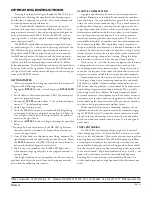
Manual-2
REAR PANEL DESCRIPTION
FRONT PANEL DESCRIPTION
XLR INPUT jacks:
These accommodates balanced signals. Rane adheres to the international and U.S. standard for balanced pin
configurations: Pin 1 is chassis ground (neutral), pin 2 is hot (positive), and pin 3 is signal return (negative)
.
Choose between this
and the ¼" TRS Input jack—use only one—they do not sum.
¼" TRS INPUT jacks:
These are TRS (tip-ring-sleeve) ¼" jacks accommodating either balanced or unbalanced signals. For un-
balanced signals use a mono ¼" TS plug (single conductor with shield), and keep its length under 10 feet (3 meters) to avoid hum
and noise. For balanced signals use microphone cable (two conductor with shield) with TRS ¼" plugs.
Choose between this and the
XLR Input jack—use only one—they do not sum.
Refer to the included RaneNote, “Sound System Interconnection” for unbalanced
wiring.
XLR OUTPUT jacks:
These balanced outputs are wired per AES standards of pin 2 “hot”, as described above in
.
¼" TRS OUTPUT jacks:
These are TRS (tip-ring-sleeve) ¼" balanced jacks compatible with either balanced or unbalanced
systems. For balanced systems, use a microphone cable wired with pin 1 is chassis ground (neutral), pin 2 is hot (positive), and pin
3 is signal return (negative)
.
Refer to the RaneNote, “Sound System Interconnection” for unbalanced wiring.
LEVEL
LEVEL
OL
OL
BYPASS
BYPASS
RANGE
RANGE
POWER
CHANNEL 1
630
100
25
40
63
250
160
400
6.3k
1k 1.6k 2.5k 4k
16k
10k
630
100
25
40
63
250
160
400
6.3k
1k 1.6k 2.5k 4k
16k
10k
ME 15B
CHANNEL 2
±12
±12
12
•
6
•
•
•
6
12
0
+
12
•
6
•
•
•
6
12
0
+
10
0
2
4
8
6
10
0
2
4
8
6
±6
±6
MICROGRAPHIC
EQUALIZER
6
•
3
•
•
•
3
6
6
•
3
•
•
•
3
6
0
+
0
+
4 3 2
1
4 3 2
1
5
WIRING
TIP / PIN 2 = POSITIVE
RING / PIN 3 = NEGATIVE
SLEEVE = SIGNAL GROUND
PIN 1 = CHASSIS GROUND
MADE IN U.S.A.
RANE CORP.
CHANNEL 2
CHANNEL 1
OUTPUT
INPUT
OUTPUT
ME 15B
INPUT
N108
50/60 Hz
12 WATTS
120 V
WARNING
TO REDUCE THE RISK OF FIRE
OR ELECTRICAL SHOCK DO
NOT EXPOSE THIS EQUIPMENT
TO RAIN OR MOISTURE. DO
NOT REMOVE COVER. NO
USER SERVICEABLE PARTS
INSIDE. REFER SERVICING TO
QUALIFIED PERSONNEL.
FOR CONTINUED GROUNDING PROTECTION
DO NOT REMOVE SCREW
4
3
1
2
4
3
1
2
Filter level slide controls:
Each of these sliders controls the output level of each of the bandpass filters. Center position is de-
tented and grounded for guaranteed flat response.
Filter RANGE switches:
The gain range of the filter sliders is switchable (as a group) from
±6 dB
for high resolution, to
±12 dB
for maximum boost/cut capability.
BYPASS switches:
When the button is pushed and the red indicator is lit, this Channel is in the BYPASS mode: signal is routed
directly from the Input to the Output without passing through any active circuitry (often referred to as “hard-wire bypass”). Use
this switch to compare equalized and unequalized material, or to bypass the equalizer in the event of power loss or unit failure.
LEVEL controls and OL indicators:
These control the level of signal coming into the ME 15B. Turn this control down if it’s
OL (OverLoad) lights up steadily (meaning too strong an Input signal). Since actual unity gain depends on varying slider settings
(which is why we have not marked a unity gain position on the front panel), use the BYPASS switch to determine the exact unity
gain position of this LEVEL control by comparing EQ and BYPASS volumes. The
OL indicator lights up if any section of the ME
15B is within 3 dB of clipping. Occasional blinking of these LEDs are acceptable, but if they remains on more than intermittently,
turn down either the equalizer’s LEVEL control(s) or reduce the output level of the preceding component to avoid audible distor-
tion.
POWER switch:
As you have astutely surmised by now, this switch powers up the ME15B (as long as the power cord is plugged
in correctly).






















